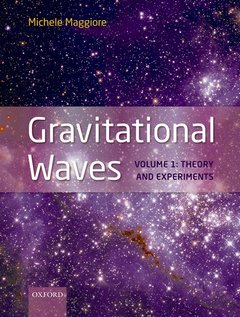Description
Gravitational Waves
Volume 1: Theory and Experiments
Author: Maggiore Michele
Language: English
Subjects for Gravitational Waves:
Publication date: 10-2007
576 p. · 19.5x25.3 cm · Hardback
576 p. · 19.5x25.3 cm · Hardback
Description
/li>Contents
/li>Biography
/li>Comment
/li>
The aim of this book is to become a major reference text for gravitational-wave physics, covering in detail both the experimental and the theoretical aspects. It is the only existing book on gravitational waves to date, and it will likely remain unique for its broadness and scope. It brings the reader to the forefront of present-day research, both theoretical and experimental, assuming no previous knowledge of gravitational-wave physics. Part I of Volume 1 is devoted to the theory of gravitational waves. Here we have re-derived - in a coherent way - most of the results that we present, clarifying or streamlining existing derivations. Part II of Volume 1 is devoted to a description of experimental gravitational-wave physics. We discuss in great detail existing and planned experiments, as well as data analysis techniques.
Part I. Gravitational-wave theory. 1. The geometric approach to GWs. 2. The field-theoretical approach to GWs. 3. Generation of GWs in linearized theory. 4. Applications. 5. GW generation by post-Newtonian sources. 6. Experimental observation of GW emission in compact binaries. Part II. Experiments. 7. Data analysis techniques. 8. Resonant-mass detectors. 9. Interferometers.
Prof. Michele Maggiore Department of Theoretical Physics, University of Geneva Born in 1963, Michele Maggiore has graduated from University of Pisa in 1986, and has got his PhD from Scuola Normale Superiore in Pisa, in 1989. After postdoctoral positions in Bern and at University of Minnesota he became researcher at INFN in Pisa in 1991. Since 2001 he is Professeur Ordinaire (Professor) at the Dept. of Theoretical Physics, University of Geneva. His research interests cover a broad range of subjects, including quantum field theory, quantum gravity, cosmology, string theory, and the study of gravitational waves of astrophysical or cosmological origin. He is also involved in experimental effors for gravitational wave detection.
The presentation of the material, including the notation and layout, is very clear. The book is written at a level that will appeal to advanced students and active researchers. [...] The book clearly fills a gap in the literature. It deserves to become a standard textbook in gravitation and to be on the book-shelf of everybody who is seriously interested in gravitational wave astronomy.
© 2024 LAVOISIER S.A.S.




